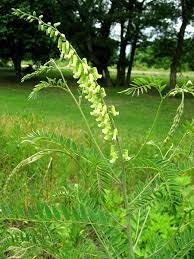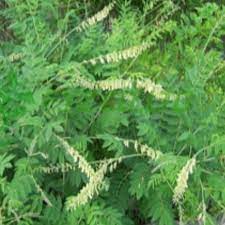Sophora flavescens, commonly known as Kushen or Chinese sophora, is a perennial shrub native to China, Korea, and Japan. Belonging to the Fabaceae family, it has been used in traditional Chinese medicine for thousands of years for its various therapeutic properties.
Kushen is characterized by its woody stems, compound leaves with small leaflets, and clusters of yellow flowers that bloom in summer. The plant is typically found in dry, rocky habitats and is cultivated for medicinal purposes.
In traditional Chinese medicine, Sophora flavescens is prized for its broad spectrum of medicinal uses. The roots of the plant contain bioactive compounds such as alkaloids, flavonoids, and quinolizidine alkaloids, which are believed to have anti-inflammatory, antibacterial, antiviral, and antifungal properties.
Kushen is commonly used to treat a range of health conditions, including skin disorders (such as eczema and psoriasis), digestive issues, respiratory infections, and inflammatory diseases. It is also used topically to promote wound healing and alleviate itching and inflammation.
Modern scientific research has supported many of the traditional uses of Kushen and has identified several bioactive compounds responsible for its pharmacological effects. These include matrine, oxymatrine, sophoridine, and sophocarpine, which have shown promise in preclinical studies for their potential anti-inflammatory, anticancer, and immunomodulatory properties.
Kushen is typically prepared as a decoction, tea, tincture, or extract for internal use. It can also be applied topically in the form of creams, ointments, or poultices for skin conditions and wound healing.
While Kushen is generally considered safe for most individuals when used as directed, it is essential to consult with a qualified healthcare professional before incorporating it into your wellness routine, especially if you have underlying health conditions or are taking medications.
Sophora flavescens, or Kushen, is a valuable medicinal plant with a long history of use in traditional Chinese medicine. Its diverse pharmacological properties make it a versatile remedy for various health concerns, and ongoing research continues to uncover its potential therapeutic applications.
The Botanical Description of Sophora flavescens
1. Plant Morphology: Sophora flavescens, commonly known as Kushen or Chinese Sophora, is a perennial shrub belonging to the Fabaceae family. It typically grows to a height of 1 to 2 meters and features multiple branches with compound leaves.
2. Leaves: The leaves of Sophora flavescens are pinnately compound, consisting of several leaflets arranged alternately along a central stem. Each leaflet is oval-shaped with a pointed tip and smooth margins.
3. Flowers: The flowers of Sophora flavescens are small, yellow, and arranged in clusters at the ends of the branches. They have a distinct pea-like appearance characteristic of plants in the Fabaceae family.
4. Fruits: After flowering, Sophora flavescens produces seed pods that are oblong and slightly curved. These pods contain several seeds and turn brown when mature. The seeds are typically dispersed by animals or wind.
5. Roots: The roots of Sophora flavescens are thick, woody, and yellowish-brown in color. They have a distinct aroma and are the main part of the plant used in traditional medicine.
6. Growth Habit: Sophora flavescens prefers well-drained soil and thrives in sunny to partially shaded locations. It is native to East Asia, including China, Japan, and Korea, where it grows in grasslands, forests, and mountainous regions.
7. Medicinal Parts: The roots of Sophora flavescens are the primary medicinal part of the plant and are harvested for their pharmacological properties. They contain bioactive compounds that have been used in traditional Chinese medicine for centuries.
8. Cultivation: Sophora flavescens can be cultivated in temperate regions with a suitable climate and soil conditions. It can be propagated from seeds or cuttings and requires regular watering and fertilization for optimal growth.
9. Seasonal Variation: The growth and flowering of Sophora flavescens are influenced by seasonal changes, with peak flowering occurring in the spring and summer months. The plant may enter a dormant phase during the winter.
10. Ornamental Use: In addition to its medicinal properties, Sophora flavescens is sometimes cultivated as an ornamental plant for its attractive foliage and flowers. It can be grown in gardens, parks, and landscaping projects.
11. Conservation Status: Sophora flavescens is not considered threatened or endangered, although habitat loss and overharvesting of wild populations may pose conservation challenges in some regions. Sustainable cultivation practices are encouraged to ensure the plant’s long-term survival.
12. Taxonomic Classification: Sophora flavescens is classified within the genus Sophora, which includes over 50 species of flowering plants distributed worldwide. It is closely related to other members of the Fabaceae family, such as Sophora japonica and Sophora tonkinensis.
The Geographic Distribution of Sophora flavescens

1. China: Sophora flavescens is native to China, where it is found in various provinces across the country, including Shandong, Jiangsu, Zhejiang, and Anhui. It grows in grasslands, forests, and mountainous regions.
2. Japan: Sophora flavescens is also native to Japan, where it occurs in both natural and cultivated habitats. It is found in regions with suitable climate and soil conditions, including Honshu, Kyushu, and Shikoku.
3. Korea: In Korea, Sophora flavescens is distributed throughout the country, from the lowlands to the highlands. It grows in a wide range of habitats, including open fields, forest edges, and rocky slopes.
4. Other Asian Countries: Sophora flavescens is also found in other Asian countries, including Taiwan, Vietnam, and Mongolia. It may have been introduced to these regions or occur naturally in similar ecological niches.
5. Cultivation: In addition to its native range, Sophora flavescens is cultivated in other parts of Asia, as well as in Europe and North America, for its medicinal properties. Cultivated populations may be found in botanical gardens, herbal farms, and research institutions.
6. Global Distribution: Sophora flavescens has been introduced to various countries outside of its native range, where it may be grown as an ornamental plant or for medicinal purposes. Its global distribution is influenced by factors such as climate, soil, and cultural practices.
7. Adaptability: Sophora flavescens exhibits a degree of adaptability to different environmental conditions, allowing it to thrive in a variety of habitats and climates. It can tolerate a range of soil types and moisture levels, although it prefers well-drained soil and moderate rainfall.
8. Invasive Potential: While Sophora flavescens is not considered invasive in most regions, there have been reports of it naturalizing and spreading in certain areas where it has been introduced. Monitoring and management strategies may be needed to prevent potential ecological impacts.
9. Conservation Status: The conservation status of Sophora flavescens varies depending on its location and the level of threat it faces from habitat loss, overharvesting, and other factors. Conservation efforts may include habitat restoration, cultivation initiatives, and sustainable harvesting practices.
10. Economic Importance: Sophora flavescens has economic importance as a source of traditional medicine, herbal remedies, and botanical products. Cultivation and trade of the plant contribute to local economies and provide livelihoods for communities involved in its production and processing.
11. Research and Conservation: Continued research and conservation efforts are needed to better understand the ecological role, genetic diversity, and conservation status of Sophora flavescens. Collaborative initiatives involving scientists, policymakers, and local stakeholders can help ensure the sustainable management of this valuable plant species.
The Chemical Composition of Sophora flavescens
1. Alkaloids: Sophora flavescens contains various alkaloids, including matrine, oxymatrine, sophocarpine, and sophoridine. These alkaloids are pharmacologically active and contribute to the plant’s medicinal properties.
2. Flavonoids: Flavonoids such as quercetin, kaempferol, and rutin are present in Sophora flavescens and possess antioxidant, anti-inflammatory, and anticancer properties. They contribute to the plant’s therapeutic effects.
3. Coumarins: Sophora flavescens contains coumarin compounds, including scopoletin and umbelliferone, which have anticoagulant, anti-inflammatory, and vasodilatory effects. These compounds may contribute to the plant’s cardiovascular benefits.
4. Triterpenoids: Triterpenoids are found in Sophora flavescens and exhibit various biological activities, including anti-inflammatory, antimicrobial, and hepatoprotective effects. They may play a role in the plant’s medicinal properties.
5. Essential Oils: The essential oils of Sophora flavescens contain volatile compounds such as terpenes, alcohols, and esters, which contribute to the plant’s aroma and may have therapeutic effects.
6. Phenolic Compounds: Sophora flavescens contains phenolic compounds, including phenolic acids and tannins, which have antioxidant, anti-inflammatory, and antimicrobial properties. These compounds contribute to the plant’s health benefits.
7. Saponins: Saponins found in Sophora flavescens have detergent-like properties and may have immunomodulatory, antifungal, and antiviral effects. They contribute to the plant’s medicinal properties and may enhance immune function.
8. Glycosides: Sophora flavescens contains glycoside compounds, including flavone glycosides and isoflavone glycosides, which have antioxidant, anti-inflammatory, and anticancer activities. These compounds contribute to the plant’s therapeutic effects.
9. Polysaccharides: Polysaccharides extracted from Sophora flavescens have immunomodulatory, antitumor, and antioxidant properties. They may enhance immune function and protect against oxidative stress.
10. Lignans: Lignan compounds found in Sophora flavescens exhibit antioxidant, anti-inflammatory, and anticancer activities. They may contribute to the plant’s health benefits and protect against chronic diseases.
11. Amino Acids: Sophora flavescens contains various amino acids, including arginine, lysine, and proline, which are essential for protein synthesis and cellular function. These amino acids may play a role in the plant’s physiological processes.
12. Minerals and Vitamins: Sophora flavescens contains minerals such as calcium, magnesium, and potassium, as well as vitamins such as vitamin C and vitamin E, which are essential for overall health and wellbeing. These nutrients contribute to the plant’s nutritional value.
13. Other Bioactive Compounds: Sophora flavescens may contain other bioactive compounds such as polysaccharides, lignans, and peptides, which have diverse pharmacological activities and contribute to the plant’s medicinal properties. Further research is needed to elucidate their specific roles.
14. Variation in Chemical Composition: The chemical composition of Sophora flavescens may vary depending on factors such as plant age, growing conditions, and extraction methods. Standardization of extract formulations is important to ensure consistency and efficacy in medicinal preparations.
Read Also: Blackleg (cruciferous plants): Description, Damages Caused, Control and Preventive Measures
The Medicinal Health Benefits Of Sophora flavescens (Kushen)

1. Antimicrobial Activity: Sophora flavescens exhibits broad-spectrum antimicrobial activity against bacteria, fungi, and viruses. It may help prevent and treat various infections, including respiratory infections, skin infections, and gastrointestinal infections.
2. Anti-inflammatory Effects: Sophora flavescens has potent anti-inflammatory properties, which may help reduce inflammation and alleviate symptoms of inflammatory conditions such as arthritis, asthma, and inflammatory bowel disease.
3. Antioxidant Protection: The antioxidants present in Sophora flavescens help neutralize harmful free radicals and oxidative stress, protecting cells and tissues from damage. Regular consumption of Sophora flavescens may help reduce the risk of chronic diseases such as cancer, cardiovascular disease, and neurodegenerative disorders.
4. Hepatoprotective Effects: Sophora flavescens has hepatoprotective properties, meaning it can help protect the liver from damage caused by toxins, drugs, and other harmful substances. It may support liver function and aid in the treatment of liver diseases such as hepatitis and liver cirrhosis.
5. Antiviral Activity: Sophora flavescens has demonstrated antiviral activity against a range of viruses, including influenza virus, herpes simplex virus, and human immunodeficiency virus (HIV). It may help prevent viral infections and reduce viral replication.
6. Anticancer Potential: Preliminary studies suggest that Sophora flavescens may have anticancer potential due to its ability to inhibit tumor growth and induce apoptosis (programmed cell death) in cancer cells. It may be used as an adjunctive therapy in cancer treatment protocols.
7. Immunomodulatory Effects: Sophora flavescens has immunomodulatory properties, meaning it can regulate the immune system and enhance immune function. It may help strengthen the body’s natural defenses against infections and diseases.
8. Antidiabetic Properties: Sophora flavescens has been investigated for its potential antidiabetic effects, including lowering blood sugar levels and improving insulin sensitivity. It may be beneficial for individuals with diabetes or at risk of developing diabetes.
9. Gastrointestinal Benefits: Sophora flavescens has been used traditionally to treat gastrointestinal disorders such as diarrhea, dysentery, and gastritis. It may help soothe digestive discomfort, reduce inflammation, and promote gastrointestinal health.
10. Respiratory Support: Sophora flavescens is commonly used in traditional medicine to treat respiratory conditions such as coughs, bronchitis, and asthma. It has bronchodilator, expectorant, and anti-inflammatory effects, which help relieve respiratory symptoms and improve lung function.
11. Antiallergic Effects: Sophora flavescens may have antiallergic properties, making it useful for managing allergic conditions such as allergic rhinitis, eczema, and allergic asthma. It may help reduce allergic reactions and alleviate allergy symptoms.
12. Cardiovascular Protection: Sophora flavescens has cardiovascular benefits, including lowering blood pressure, reducing cholesterol levels, and improving blood circulation. It may help reduce the risk of heart disease, stroke, and other cardiovascular disorders.
13. Neuroprotective Effects: Sophora flavescens has neuroprotective properties, meaning it can help protect the brain and nervous system from damage caused by oxidative stress, inflammation, and neurodegenerative diseases. It may support cognitive function and brain health.
14. Wound Healing: Sophora flavescens has been used topically to promote wound healing and tissue repair. It may have antimicrobial, anti-inflammatory, and tissue-regenerating effects that accelerate the healing process and reduce the risk of infection.
15. Antispasmodic Action: Sophora flavescens has antispasmodic properties, meaning it can help relax smooth muscle tissue and alleviate muscle spasms, cramps, and gastrointestinal discomfort. It may be useful for relieving menstrual cramps, stomach cramps, and irritable bowel syndrome (IBS).
16. Antipyretic Effects: Sophora flavescens has antipyretic properties, meaning it can help reduce fever and lower body temperature. It may be used to manage fever associated with infections, inflammatory conditions, and other causes.
The Methods of Usage to Achieve the Provided Health Benefits Of Sophora flavescens (Kushen)
1. Herbal Tea: Prepare a decoction or infusion of Sophora flavescens roots or aerial parts to make a medicinal tea. Steep the dried or fresh plant material in hot water for 10-15 minutes, then strain and drink. This method is beneficial for respiratory health, immune support, and gastrointestinal issues.
2. Tincture: Prepare a tincture of Sophora flavescens by macerating the dried or fresh plant material in alcohol or glycerin. Tinctures can be taken orally by adding a few drops to water or juice. This method allows for convenient dosing and may enhance the plant’s medicinal effects.
3. Capsules or Tablets: Take Sophora flavescens supplements in the form of capsules or tablets, available in standardized doses for easy administration. Follow the dosage instructions provided on the product label or as recommended by a healthcare professional. This method ensures consistent intake of the plant’s active compounds.
4. Topical Preparations: Apply Sophora flavescens extracts or ointments topically to the skin to treat wounds, cuts, burns, and skin infections. These preparations may have antimicrobial, anti-inflammatory, and wound-healing properties. Cleanse the affected area before applying the product and cover with a bandage if necessary.
5. Inhalation Therapy: Inhale steam from a hot infusion or decoction of Sophora flavescens to relieve respiratory symptoms such as coughs, congestion, and asthma. Add the prepared herbal solution to a bowl of hot water, cover your head with a towel, and inhale the steam for 5-10 minutes. This method helps open the airways and soothe respiratory discomfort.
6. Poultice: Prepare a poultice of crushed Sophora flavescens roots or leaves mixed with water or oil to apply directly to the skin. Poultices can be used to reduce inflammation, relieve pain, and promote healing of bruises, sprains, and muscle soreness. Apply the poultice to the affected area and cover with a clean cloth or bandage.
7. Mouthwash or Gargle: Prepare a mouthwash or gargle solution using a diluted infusion or tincture of Sophora flavescens to promote oral health and alleviate sore throat, mouth ulcers, and gum inflammation. Rinse or gargle with the solution for 30 seconds to 1 minute, then spit out. Repeat as needed throughout the day.
8. Herbal Bath: Add dried or fresh Sophora flavescens leaves, roots, or extracts to a warm bath to relax muscles, soothe skin irritation, and promote overall wellbeing. Soak in the herbal bath for 15-30 minutes to experience the plant’s therapeutic effects. This method is especially beneficial for relieving stress and tension.
9. Compress: Prepare a warm or cold compress using an infusion or decoction of Sophora flavescens to apply to swollen joints, bruises, or insect bites. Soak a clean cloth in the herbal solution, wring out excess liquid, and apply to the affected area for 10-15 minutes. Repeat as needed to reduce pain and inflammation.
10. Steam Inhalation: Add dried Sophora flavescens roots or leaves to a pot of boiling water and inhale the steam to clear nasal congestion, sinusitis, and respiratory infections. Cover your head with a towel and lean over the pot, breathing deeply for 5-10 minutes. This method helps loosen mucus and improve breathing.
11. Eye Wash: Prepare an eye wash solution using a diluted infusion of Sophora flavescens to cleanse and soothe irritated eyes, conjunctivitis, and eye infections. Rinse the eyes with the herbal solution using an eye cup or dropper. Avoid contact with the eyes and consult a healthcare professional if irritation persists.
12. Massage Oil: Mix Sophora flavescens extract or essential oil with a carrier oil such as coconut oil or almond oil to create a massage oil for joint pain, muscle tension, and inflammation. Massage the oil into the affected area using circular motions to promote relaxation and relieve discomfort. Adjust the oil concentration based on skin sensitivity.
13. Dietary Supplement: Incorporate Sophora flavescens supplements or extracts into your daily diet to support overall health and wellbeing. Add powdered extracts to smoothies, juices, or food recipes, or take capsules/tablets with meals. Consult a healthcare professional for personalized dosage recommendations and guidance.
The Side Effects Of Using Sophora flavescens Medicinal Plant
1. Gastrointestinal Disturbances: Some individuals may experience gastrointestinal side effects such as nausea, vomiting, diarrhea, or abdominal discomfort when using Sophora flavescens supplements or extracts. These effects are usually mild and temporary.
2. Allergic Reactions: Allergic reactions to Sophora flavescens, including skin rash, itching, swelling, or difficulty breathing, may occur in sensitive individuals. Discontinue use and seek medical attention if allergic symptoms develop.
3. Drug Interactions: Sophora flavescens may interact with certain medications, including blood thinners, anticoagulants, antidiabetic drugs, and immunosuppressants. Consult a healthcare professional before combining Sophora flavescens with prescription medications.
4. Pregnancy and Breastfeeding: Pregnant and breastfeeding women should avoid Sophora flavescens due to limited safety data. The plant may have uterine-stimulating effects and potential risks to fetal development.
5. Liver Toxicity: High doses or prolonged use of Sophora flavescens may cause liver toxicity and hepatotoxicity in some individuals. Monitor liver function tests regularly when using Sophora flavescens supplements or extracts.
6. Photosensitivity: Sophora flavescens may increase sensitivity to sunlight and UV radiation, leading to sunburn, skin irritation, or pigmentation changes. Use sun protection measures such as sunscreen and protective clothing when exposed to sunlight.
7. Hypotension: Sophora flavescens may lower blood pressure, especially in individuals with hypotension or taking antihypertensive medications. Monitor blood pressure levels regularly and adjust medication dosage as needed.
8. Hormonal Effects: Sophora flavescens contains phytoestrogens that may affect hormone levels and menstrual cycles in some individuals. Use caution when using Sophora flavescens supplements or extracts, especially in individuals with hormone-sensitive conditions.
9. Central Nervous System Effects: Some individuals may experience central nervous system side effects such as dizziness, headache, or drowsiness when using Sophora flavescens supplements or extracts. Use caution when operating machinery or driving.
10. Renal Toxicity: Prolonged use of Sophora flavescens may lead to renal toxicity and kidney damage in some individuals. Monitor kidney function tests regularly and stay hydrated when using Sophora flavescens supplements or extracts.
11. Cardiovascular Effects: Sophora flavescens may affect heart rhythm and cardiovascular function, especially in individuals with pre-existing heart conditions or taking cardiac medications. Monitor heart rate and rhythm regularly when using Sophora flavescens supplements or extracts.
12. Neurological Symptoms: Rarely, individuals may experience neurological symptoms such as tremors, seizures, or confusion when using Sophora flavescens supplements or extracts. Discontinue use and seek medical attention if neurological symptoms occur.
13. Respiratory Effects: Some individuals may experience respiratory side effects such as coughing, wheezing, or shortness of breath when using Sophora flavescens supplements or extracts. Discontinue use and seek medical attention if respiratory symptoms persist.
14. Dermatological Reactions: Topical application of Sophora flavescens extracts or preparations may cause skin irritation, redness, or allergic dermatitis in sensitive individuals. Perform a patch test before use and discontinue if adverse reactions occur.
15. Musculoskeletal Effects: Rarely, individuals may experience musculoskeletal side effects such as muscle weakness, joint pain, or arthritis-like symptoms when using Sophora flavescens supplements or extracts. Discontinue use and consult a healthcare professional if musculoskeletal symptoms develop.
Read Also: 17 Medicinal Health Benefits Of Lotus Seed (Nelumbo nucifera)
The Scientific Research and Studies of Sophora flavescens

1. Antimicrobial Activity: Research studies have demonstrated the antimicrobial activity of Sophora flavescens against various bacteria, fungi, and viruses, including antibiotic-resistant strains. Its bioactive compounds, such as alkaloids and flavonoids, exhibit potent antimicrobial effects.
2. Anti-inflammatory Effects: Sophora flavescens has been shown to possess significant anti-inflammatory properties, which may help reduce inflammation and alleviate symptoms of inflammatory diseases such as arthritis, asthma, and inflammatory bowel disease.
3. Antioxidant Protection: Numerous studies have confirmed the antioxidant activity of Sophora flavescens, which helps neutralize free radicals and oxidative stress, protecting cells and tissues from damage. Its flavonoids, coumarins, and phenolic compounds contribute to its antioxidant effects.
4. Hepatoprotective Effects: Animal and cell culture studies have demonstrated the hepatoprotective effects of Sophora flavescens against liver damage induced by toxins, drugs, and alcohol. Its bioactive compounds, including alkaloids and saponins, help support liver function and regeneration.
5. Antiviral Activity: In vitro and in vivo studies have shown that Sophora flavescens exhibits potent antiviral activity against a wide range of viruses, including influenza virus, herpes simplex virus, and human immunodeficiency virus (HIV). Its alkaloids, flavonoids, and triterpenoids inhibit viral replication and infection.
6. Anticancer Potential: Preclinical studies have investigated the anticancer potential of Sophora flavescens against various types of cancer, including breast cancer, lung cancer, and liver cancer. Its bioactive compounds, such as matrine and oxymatrine, induce apoptosis and inhibit tumor growth.
The Safety Precautions and Recommendations In Using Sophora flavescens Medicinal Plant
1. Consultation with Healthcare Professional: Before using Sophora flavescens supplements or extracts, consult a healthcare professional, especially if you have underlying health conditions, are pregnant or breastfeeding, or are taking medications. A healthcare professional can provide personalized recommendations and monitor for potential interactions or side effects.
2. Dosage Guidelines: Follow the recommended dosage guidelines provided on the product label or as advised by a healthcare professional. Avoid exceeding the recommended dose, as high doses may increase the risk of side effects or toxicity.
3. Quality and Purity: Choose Sophora flavescens supplements or extracts from reputable manufacturers that adhere to quality standards and undergo testing for purity, potency, and safety. Look for products that are standardized for bioactive compounds and free from contaminants.
4. Allergy Testing: Perform a patch test before using Sophora flavescens topically to check for allergic reactions or skin sensitivity. Apply a small amount of the product to a small area of skin and monitor for any adverse reactions such as redness, itching, or swelling.
5. Monitoring and Reporting: Monitor for any adverse reactions or side effects when using Sophora flavescens supplements or extracts. Discontinue use and seek medical attention if you experience any symptoms of allergic reactions, gastrointestinal disturbances, liver toxicity, or other adverse effects.
6. Sun Protection: If using Sophora flavescens topically or orally, take precautions to protect your skin from sunlight and UV radiation. Apply sunscreen with a high SPF, wear protective clothing, and avoid prolonged sun exposure, especially during peak hours.
7. Storage and Handling: Store Sophora flavescens supplements or extracts in a cool, dry place away from direct sunlight, heat, and moisture. Follow the manufacturer’s instructions for storage and handling to maintain product quality and potency.
8. Pregnancy and Breastfeeding: Pregnant and breastfeeding women should avoid using Sophora flavescens due to limited safety data and potential risks to fetal development or nursing infants. Consult a healthcare professional for alternative treatment options.
9. Children and Elderly: Use caution when administering Sophora flavescens supplements or extracts to children or elderly individuals, as they may be more sensitive to the effects or have underlying health conditions that require dose adjustments or monitoring.
10. Drug Interactions: Sophora flavescens may interact with certain medications, including blood thinners, antidiabetic drugs, immunosuppressants, and cardiac medications. Consult a healthcare professional before combining Sophora flavescens with prescription medications to prevent potential interactions or adverse effects.
11. Herbal Precautions: If using Sophora flavescens in combination with other herbal supplements or remedies, exercise caution and monitor for potential interactions or additive effects. Some herbal combinations may enhance or inhibit the effects of Sophora flavescens, leading to unpredictable outcomes.
12. Reporting Adverse Events: If you experience any adverse events or side effects when using Sophora flavescens supplements or extracts, report them to the relevant regulatory authorities or healthcare professionals for further investigation and monitoring. Your feedback can help improve product safety and consumer protection.
13. Long-term Use: Avoid prolonged or excessive use of Sophora flavescens supplements or extracts without medical supervision. Long-term use may increase the risk of adverse effects, toxicity, or tolerance development.
14. Alternative Therapies: Consider complementary or alternative therapies in addition to or instead of Sophora flavescens for managing specific health conditions. Explore other herbal remedies, dietary supplements, lifestyle modifications, and conventional treatments under the guidance of a healthcare professional.
FAQs About Sophora flavescens Medicinal Plant
1. What is Sophora flavescens?
Sophora flavescens, also known as Kushen or Chinese Sophora, is a perennial shrub native to East Asia. It has a long history of use in traditional Chinese medicine for its medicinal properties.
2. What are the medicinal health benefits of Sophora flavescens?
Sophora flavescens has numerous medicinal health benefits, including antimicrobial, anti-inflammatory, antioxidant, hepatoprotective, antiviral, anticancer, immunomodulatory, and respiratory support properties.
3. How is Sophora flavescens used in traditional medicine?
Sophora flavescens is used in traditional medicine to treat various health conditions, including infections, inflammation, liver disorders, viral diseases, cancer, immune disorders, respiratory ailments, allergies, and gastrointestinal issues.
4. What are the methods of usage for Sophora flavescens?
Sophora flavescens can be used internally as a tea, tincture, capsules, tablets, or herbal supplement, and externally as a topical preparation, poultice, compress, mouthwash, or gargle. It can also be inhaled as steam or added to bath water for therapeutic benefits.
5. Are there any side effects of using Sophora flavescens?
While Sophora flavescens is generally considered safe when used as directed, it may cause side effects such as gastrointestinal disturbances, allergic reactions, drug interactions, liver toxicity, photosensitivity, hormonal effects, and neurological symptoms in some individuals.
6. Can Sophora flavescens be used during pregnancy or breastfeeding?
Pregnant and breastfeeding women should avoid using Sophora flavescens due to limited safety data and potential risks to fetal development or nursing infants. Consult a healthcare professional for alternative treatment options.
7. Is Sophora flavescens safe for children and elderly individuals?
Use caution when administering Sophora flavescens supplements or extracts to children or elderly individuals, as they may be more sensitive to the effects or have underlying health conditions that require dose adjustments or monitoring.
8. Are there any drug interactions with Sophora flavescens?
Sophora flavescens may interact with certain medications, including blood thinners, antidiabetic drugs, immunosuppressants, and cardiac medications. Consult a healthcare professional before combining Sophora flavescens with prescription medications to prevent potential interactions or adverse effects.
9. How should Sophora flavescens supplements or extracts be stored?
Store Sophora flavescens supplements or extracts in a cool, dry place away from direct sunlight, heat, and moisture. Follow the manufacturer’s instructions for storage and handling to maintain product quality and potency.
10. Where can I find Sophora flavescens products?
Sophora flavescens supplements, extracts, and herbal preparations are available from health food stores, online retailers, herbal pharmacies, and traditional Chinese medicine shops. Choose products from reputable manufacturers that adhere to quality standards and undergo testing for purity, potency, and safety.






